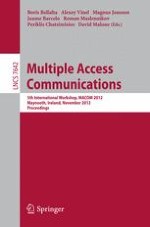2012 | Buch
Multiple Access Communications
5th International Workshop, MACOM 2012, Maynooth, Ireland, November 19-20, 2012. Proceedings
herausgegeben von: Boris Bellalta, Alexey Vinel, Magnus Jonsson, Jaume Barcelo, Roman Maslennikov, Periklis Chatzimisios, David Malone
Verlag: Springer Berlin Heidelberg
Buchreihe : Lecture Notes in Computer Science
